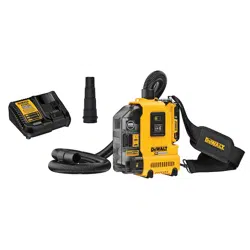Loading ...
Loading ...
Loading ...

ENGLISH
2
IMPORTANT SAFETY
INSTRUCTIONS
READ ALL INSTRUCTIONS BEFORE
USING THIS DUST EXTRACTOR
WARNING: To reduce the risk of fire,
electric shock, or injury:
• DO NOT allow to be used as a toy. Close attention
is necessary when used by or nearchildren.
• USE ONLY as described in this manual. Use only
manufacturer’s recommendedattachments.
• DO NOT use a damaged dust extractor. If
appliance is not working as it should, has been
dropped, damaged, left outdoors, or dropped into
water, return it to a servicecenter.
• DO NOT handle plug or appliance with
wethands.
• DO NOT put any object into openings. Do not use
with any opening blocked; keep free of dust, lint,
hair, and anything that may reduce airflow.
• KEEP hair, loose clothing, fingers, and all parts of
body away from openings and movingparts.
• TURN OFF all controls beforeunplugging.
• USE EXTRA CARE when cleaning onstairs.
• DO NOT use to pick up flammable or combustible
liquids, such as gasoline, or use in areas where
they may bepresent.
• DO NOT pick up anything that is burning
or smoking, such as cigarettes, matches, or
hotashes.
• DO NOT use without a filter inplace.
SAVE THESE INSTRUCTIONS
Personal Safety
a ) Prevent unintentional starting. Ensure the switch
is in the off-position before connecting to battery
pack, picking up or carrying the appliance.
Carrying the appliance with your finger on the switch
or energizing appliance that have the switch on
invitesaccidents.
b ) Disconnect the battery pack from the appliance
before making any adjustments, changing
accessories, or storing appliance. Such preventive
safety measures reduce the risk of starting the
applianceaccidentally.
c ) Recharge only with the charger specified by the
manufacturer. A charger that is suitable for one type
of battery pack may create a risk of fire when used
with another batterypack.
d ) Use appliances only with specifically designated
battery packs. Use of any other battery packs may
create a risk of injury andfire.
e ) When battery pack is not in use, keep it away
from other metal objects, like paper clips, coins,
keys, nails, screws or other small metal objects,
that can make a connection from one terminal to
another. Shorting the battery terminals together may
cause burns or afire.
f ) Under abusive conditions, liquid may be ejected
from the battery; avoid contact. If contact
accidentally occurs, flush with water. If liquid
contacts eyes, additionally seek medical help.
Liquid ejected from the battery may cause
irritation or burns.
g ) Do not use a battery pack or appliance that
is damaged or modified. Damaged or modified
batteries may exhibit unpredictable behavior resulting
in fire, explosion or risk ofinjury.
h ) Do not expose a battery pack or appliance
to fire or excessive temperature. Exposure to
fire or temperature above 104°F (40°C) may
causeexplosion.
i ) Follow all charging instructions and do not
charge the battery pack or appliance outside
of the temperature range specified in the
instructions. Charging improperly or at temperatures
outside of the specified range may damage the
battery and increase the risk offire.
j ) Have servicing performed by a qualified repair
person using only identical replacement parts.
This will ensure that the safety of the product
ismaintained.
k ) Do not modify or attempt to repair the appliance
or the battery pack expect as indicated in the
instructions for use and care.
WARNING: Some household dust contains chemicals
known to the State of California to cause cancer, birth
defects or other reproductive harm such as asbestos
and lead in lead based paint.
Additional Safety Information
WARNING: Never modify the power tool or any part
of it. Damage or personal injury couldresult.
WARNING: ALWAYS use safety glasses. Everyday
eyeglasses are NOT safety glasses. Also use face or
dust mask if cutting operation is dusty. ALWAYS WEAR
CERTIFIED SAFETYEQUIPMENT:
• ANSI Z87.1 eye protection (CAN/CSA Z94.3),
• ANSI S12.6 (S3.19) hearing protection,
• NIOSH/OSHA/MSHA respiratoryprotection.
WARNING: Some dust created by power sanding,
sawing, grinding, drilling, and other construction
activities contains chemicals known to the State
of California to cause cancer, birth defects or
other reproductive harm. Some examples of these
chemicalsare:
• lead from lead-based paints,
• crystalline silica from bricks and cement and other
masonry products, and
• arsenic and chromium from chemically-
treatedlumber.
Loading ...
Loading ...
Loading ...
